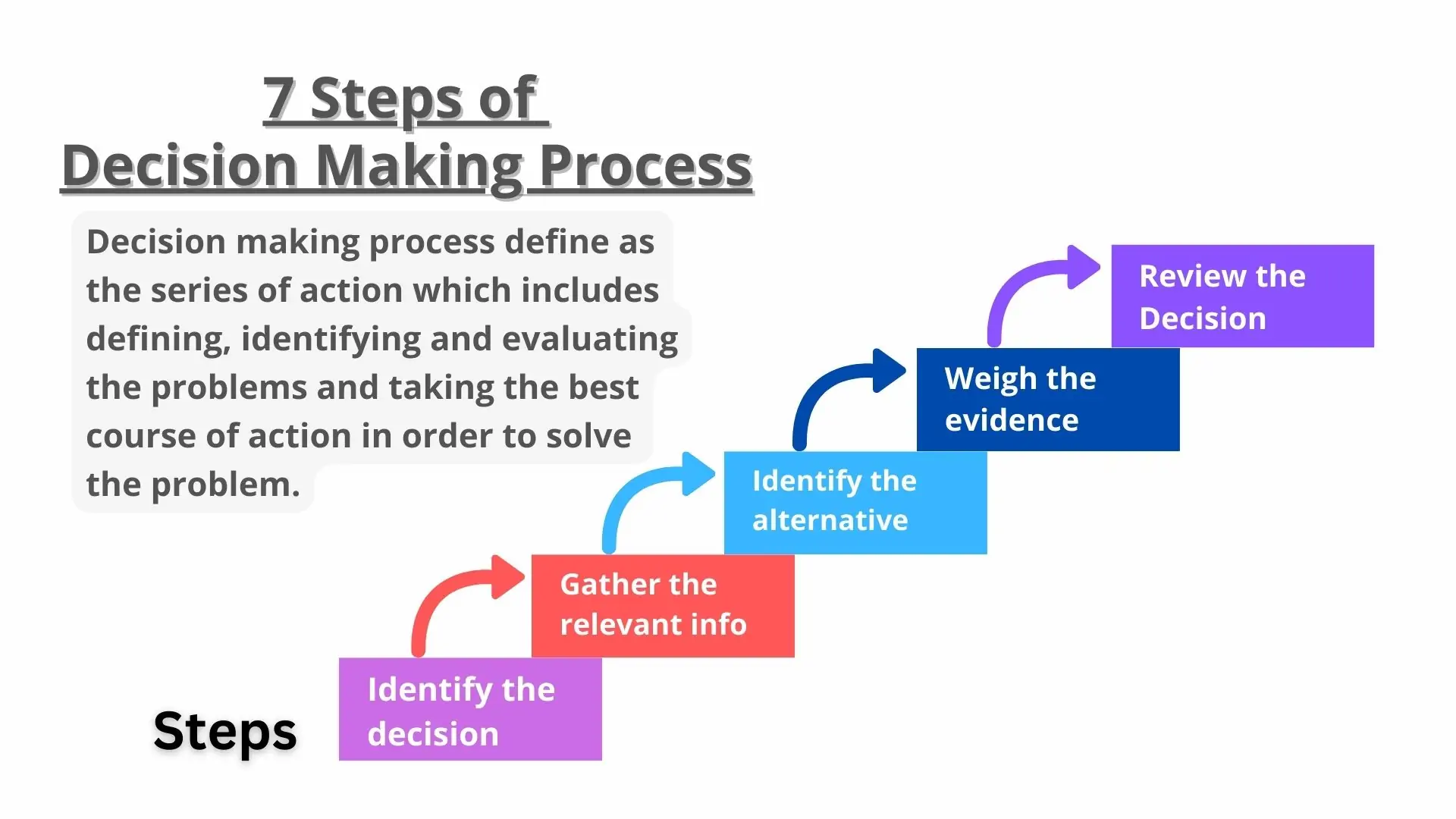Every day, you have to make decisions in your life to get tasks done or to solve the problems which comes in front of you. For example: whether to buy a donut or pizza. Many decisions can be quite complicated, but it doesn’t have to be that way if you follow a process. In this article, we are going to discuss about the decision making process. Before going to study about the of decision making steps, let’s take a view what is decision making process?

What is decision making process?
Decision making define as the process of solving organizational problems by choosing the best course of action from among several alternatives. And the process means series of action or steps to be taken to achieve desired goals. Thus, decision making process define as the series of action which includes defining, identifying and evaluating the problems and taking the best course of action in order to solve the problem.
7 steps of decision making process
- Identify the decision
- Gather relevant info
- Identify the alternative
- Weigh the evidence
- Choose among the alternative
- Take action
- Review the decision
Identify the decision
‘Identify the decision’ is the first step of decision making process. In this step, decision makers defining the problem which need to be solved or for which the decision have to be taken. Here, problem means a discrepancy between an existing and a desired state and defining means deciding what the main issues of problem are. Problem may arise in organization due to internal and external environment factors.
For Example- Suppose the company face the problem of ‘Heavy Loss’. There are many reason of it. It may due to low production and low sell, low demand in market, low quality product, inadequate advertisement etc. Decision maker have to identify the reason why company suffer from heavy loss.
Gather the information
It is the second step of decision making process. In this step, decision maker collect the data, facts and information about the problem faced by organization. This step emphasizes on finding the main reason of the problem based on collection and analysis of data and information. Data and information is collected from internal and external sources. Internal sources- balance sheet, Income statement, internal research document and other documents of the company. External sources- market search by the consultant, outsources experts etc.
To assist in the process of data collection, the following questioning framework is helpful:
- What is the real problem, and what are the principal components or elements making up the problem?
- Where did the problem occur? Why did it occur there?
- When did the problem occur? Why did it occur at that time?
- How did the problem occur? Why did it occur in that way?
- To whom did the problem occur? Why did it occur to him or her (or them)
Source: Buddha publication, by PREM R PANT, p.no157, publish on 2003
For Example- If Company face the problem of ‘heavy losses. Then, decision maker have to collect the information about the causes of it. There are many causes or reason of this problem. It may due to low production and low sell, low demand in market, low quality product etc. Decision makers have support this reason with factual data and information and find out the main reason behind the problem (heavy loss).
Let’s assume, in our case low demand in market is the main reason behind the heavy loss of the company. The principle components of this problem (low market demand) is due to high price of product.
Identify the alternative
It is the third step of decision making process. There are hundred thousand of alternative to solve a single problem. Manager have to identify several alternative solution to a problem as much as possible by reviewing and analyzing the data, information collected in above step. It depends upon the knowledge, skills, experience, critical thinking ability and imagination power of a manager and others members involve in decision making process. In this modern age, there is also the culture of hiring experts to find out the various alternative solution to a problem.
For example; in our case low market demand (due to high price of product) is the main reason of a problem (heavy loss). There are several alternative to minimize the price of product. For instant, reducing the wastage of raw material, install a new machine which productivity is high at least cost, direct sells of product to customer and eliminate the cost of retailer and wholesaler which ultimately reduced the price of product and other more.
Weigh the evidence
It is the fourth step in decision making process. In this step, decision makers have to evaluate all the alternative that were identified in step 3. Evaluation of alternative is done based on:
- Cost factor
- Risk factor
- Time factor, etc.
Beside it, decision maker also have to consider that, is the solution is effective for the organization or not? And its consequence after implementation on organization.
Choose among the alternative
It is the fifth step of decision making process. In this step, decision maker choose one of the best alternative based on evaluation between them. The alternative must be favorable to the organization. Decision maker also have to consider long-term and short term impact of the selected alternative.
For example: in our case, let’s take the alternative ‘reducing the wastage of raw material to reduce the cost of product and ultimately the price of product’. It is because company have not to make any of the expense on it, company have to only manage the resource and motivate the employee not to waste the raw material in production process.
Take action
It is the second last step of decision making process. In this step, the selected alternative is implemented in the organization. For effective implementation of alternative, action plans are developed to indicate more precisely the various roles and responsibility, what need to be delivered by whom, and also how progress will be measured and evaluated.
Review the decision
‘Review the decision’ is the last step of decision making process. After implementing the alternative solution in the organization, manager have to evaluate the progress at regular interval of time to know whether the objective of decision making process is fulfill or not. Manager have to evaluate the situation of organization between previous (in step 1) and now in the present. If the problem is solved, then no need to take any action but if not then manager have to repeat the decision making process again.
